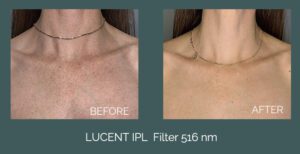How It Works
We are all born with a glowing complexion, but as we age a variety of skin conditions can begin to impact the appearance of your skin. Sun damage, acne, age spots, and broken capillaries can leave us wanting to cover our skin with makeup.
- Do you have brown pigment such as age or sunspots? Unwanted freckles or melasma?
- Have you noticed visible vessels on your face, also known as spider veins?
- Do you have redness (Rosacea) across your cheeks nose or chin?
- Has your complexion become dull? Is it in need of an overall brightening treatment?
Intense Pulse Light (IPL) treatment is a procedure preformed to target these specific skin concerns. IPL utilizes high-intensity pulses of multiple wavelengths of light. When we “zap” the skin during treatment, pigmentation is heated and your body pushes the unwanted cells to the surface where they slough off, skin firming proteins like collagen and elastin are also stimulated during treatment. Because IPL uses multiple wavelengths it can target a range of skin conditions such as:
- Dark spots (sun damage) or Melasma
- Broken blood vessels
- Brown spots (age spots)
- Redness from Rosacea
- Acne
Treatments are typically 30-45 minutes long, with minimal discomfort, it is comparable to that of a mild elastic snap on the skin. Safety eyewear is worn during the treatment as the light is very bright, similar to that of someone using a camera flash in the dark.
IPL treatments are gentler on the skin than laser treatments, resulting in minimal downtime. The skin may be slightly red after treatment and feel warm. Afterwards, the targeted skin discoloration will darken. This is normal and is the desired result of the treatment. These darkened spots will then slough off 5-7 days later.
Optimal results are obtained with 3-4 treatments spaced 3 weeks apart. Maintenance is then recommended as needed in the fall and winter months.
FAQ's
-
Are IPL photofacials safe for all skin types?
IPL is considered safe for skin types 1 to 4. People with skin types 5 and 6 are not considered safe candidates.
-
What are the side effects and risks of IPL photofacials?
Potential side effects and risks exist with all aesthetic treatments. During a consultation your provider will ask you questions to identify if you are a good candidate for treatment and if there are any factors that could put you at increased risk for side effects.
Potential side effects and risks associated with IPL include burning sensation of treated skin up to 1 hour post treatment, blisters that take 5-10 days to heal, swelling lasting a few hours up to 7 days, fragile skin, and more rare side effects such as scarring, bruising, and burns.
Avoiding sun exposure for 1 month following treatment is necessary otherwise you are at increased risk of pigmentation changes, slight redness, slight swelling, tingling sensation of treated area, darkening of pigmentation for the week following treatment until the pigment sloughs off.
-
What areas of the body can be treated with IPL photofacial? Any limitations?
Most common area treated is the face. The decollete, hands, and back can also be treated.
-
What should I do to prepare for an IPL photofacial session?
- It is imperative to avoid sun exposure and tanning beds for at least 4 weeks prior to your treatment.
- Do not apply self tanner for 2 weeks prior to treatment.
- Avoid blood thinners including Aspirin and Ibuprofen for 1 week prior to treatment.
- Inform your technician if you have taken Accutane in the past year.
- Cosmetic injections such as neurotoxin, fillers, and Sculptra must be spaced 2 weeks prior/2 weeks after treatment.
- If you were or are taking antibiotics you must finish the medication as prescribed and have 2 weeks between finishing the medication and your IPL treatment.
-
Can IPL photofacial treat fine lines and wrinkles?
IPL photofacial does not treat fine lines and wrinkles however it stimulates collagen and elastin production which can help improve signs of aging.
-
Is IPL photofacial suitable for treating acne and acne scars?
IPL is a great treatment option for managing acne, however, acne scarring is best treated with CO2 laser resurfacing.
-
What OTHER skin treatments exist for the same issues? How do they compare?
Chemical peels are helpful at improving skin brightness and managing acne.
Vivier has skincare products specifically for treatment of hyperpigmentation, redness, and acne.
Being on a good Vivier skincare routine, having a minimum of 1 chemical peel followed by IPL photofacial is the ideal treatment regimen.
-
Is there downtime after a treatment?
After your IPL treatment your skin will commonly feel warm, like you received a sunburn, your skin may also be slightly pink or mildly red depending on your skins sensitivity. If brown pigment was the target of the treatment then in the days following your treatment expect the brown pigment to darken, resembling coffee grinds on the face. This is the desired effect and will slough off a few days after treatment.
-
How much are IPL treatments?
Individual treatment cost varies depending on the size and concern being treated. A consultation is needed for pricing.
Want to chat with our experts?
If you are wondering which surgical procedure would best meet your aesthetic goals, book in for a consultation with our board certified plastic surgeon. Please click below!
BOOK A CONSULTATION


